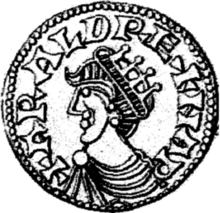

King of Norway
1015 Ringerike, Norway
25 September 1066(1066-09-25) (50–51) Stamford Bridge, Yorkshire, England
NamesHaraldr Sigurðarson
"Harold III" redirects here. For other people with similar names, see Harald III. 11th-century King of Norway Harald HardradaCoin of Harald as the sole Norwegian king, "ARALD REX NAR". Imitation of a type of Edward the Confessor.King of NorwayReign1046 – 25 September 1066PredecessorMagnus ISuccessorMagnus IICo-rulerMagnus I (until 1047)Bornc. 1015 Ringerike, NorwayDied25 September 1066(1066-09-25) (aged 50–51) Stamford Bridge, Yorkshire, EnglandBurialTrondheim; Mary Church until 12th century, Helgeseter Priory until 17th century (demolished)SpouseElisiv of Kiev Tora TorbergsdatterIssueIngegerd, Queen of Denmark and Sweden Maria Haraldsdatter Magnus II, King of Norway Olaf III, King of NorwayHouseHardradaFatherSigurd SyrMotherÅsta GudbrandsdatterReligionCatholicism Harald Sigurdsson, also known as Harald of Norway (Old Norse: Haraldr Sigurðarson; c. 1015 – 25 September 1066) and given the epithet Hardrada (Old Norse: harðráði, modern Norwegian: Hardråde, roughly translated as "stern counsel" or "hard ruler") in the sagas, was King of Norway (as Harald III) from 1046 to 1066. In addition, he unsuccessfully claimed both the Danish throne until 1064 and the English throne in 1066. Before becoming king, Harald had spent around fifteen years in exile as a mercenary and military commander in Kievan Rus' and of the Varangian Guard in the Byzantine Empire. When he was fifteen years old, in 1030, Harald fought in the Battle of Stiklestad together with his half-brother Olaf Haraldsson (later Saint Olaf). Olaf sought to reclaim the Norwegian throne, which he had lost to the Danish king Cnut the Great two years prior. In the battle, Olaf and Harald were defeated by forces loyal to Cnut, and Harald was forced into exile to Kievan Rus' (the sagas' Garðaríki). He thereafter spent some time in the army of Grand Prince Yaroslav the Wise, eventually obtaining rank as a captain, until he moved on to Constantinople with his companions around 1034. In Constantinople, he soon rose to become the commander of the Byzantine Varangian Guard, and saw action on the Mediterranean Sea, in Asia Minor, Sicily, possibly in the Holy Land, Bulgaria and in Constantinople itself, where he became involved in the imperial dynastic disputes. Harald amassed considerable wealth during his time in the Byzantine Empire, which he shipped to Yaroslav in Kievan Rus' for safekeeping. He finally left the Byzantines in 1042, and arrived back in Kievan Rus' in order to prepare his campaign of reclaiming the Norwegian throne. Possibly to Harald's knowledge, in his absence the Norwegian throne had been restored from the Danes to Olaf's illegitimate son Magnus the Good. In 1046, Harald joined forces with Magnus's rival in Denmark (Magnus had also become king of Denmark), the pretender Sweyn II of Denmark, and started raiding the Danish coast. Magnus, unwilling to fight his uncle, agreed to share the kingship with Harald, since Harald in turn would share his wealth with him. The co-rule ended abruptly the next year as Magnus died, and Harald thus became the sole ruler of Norway. Domestically, Harald crushed all local and regional opposition, and outlined the territorial unification of Norway under a national governance. Harald's reign was probably one of relative peace and stability, and he instituted a viable coin economy and foreign trade. Probably seeking to restore Cnut's "North Sea Empire", Harald also claimed the Danish throne, and spent nearly every year until 1064 raiding the Danish coast and fighting his former ally, Sweyn. Although the campaigns were successful, he was never able to conquer Denmark. Not long after Harald had renounced his claim to Denmark, the former Earl of Northumbria, Tostig Godwinson, brother of the newly chosen (but reigning not for long) English king Harold Godwinson (also known as Harold of Wessex), pledged his allegiance to Harald and invited him to claim the English throne. Harald went along and invaded Northern England with 10,000 troops and 300 longships in September 1066, raided the coast and defeated English regional forces of Northumbria and Mercia in the Battle of Fulford near York on 20 September 1066. Although initially successful, Harald was defeated and killed in a surprise attack by Harold Godwinson's forces in the Battle of Stamford Bridge on 25 September 1066, which wiped out almost his entire army. Modern historians have often considered Harald's death, which brought an end to his invasion, as the end of the Viking Age.

We use cookies
We use cookies and other tracking technologies to improve your browsing experience on our website, to show you personalized content and targeted ads, to analyze our website traffic, and to understand where our visitors are coming from. Privacy Policy.